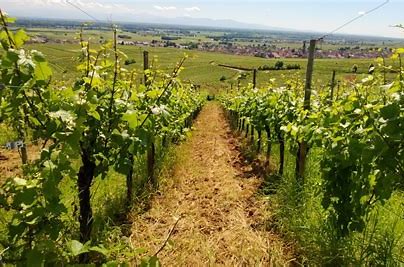The Alsace wine region
The hills exposed along the rivers of Europe usually create dignified conditions for viticulture. This was known as early as the Roman times and this has been the case also in the Rhine Valley. From the lake Constance, on the border of Germany, Switzerland and Austria, the vineyards spread out on both sides of the river without any significant interruption until Bonn. We are in the middle of Europe, where people from different countries, different cultures strive for the same thing; to farm their land and produce wine. Alsace as a wine region is no exception. From Strasbourg in the north, to Thann next to Mulhouse in the south runs the Alsace vineyard. The wine terraces on the western side of the Rhine is both climatically protected from the Atlantic winds in the west and well exposed to the sun.
Alsace as a wine region is known mainly for its white wines. 80% of total production is dry, which is rather surprising considering the sweet wine’s reputation. The maturation process of the grapes is slower here than in more southerly regions. This fosters the development of the grape’s aromatic properties.
On top of this, the usage of typical Alsace grape varieties creates wines which often have a strong character. In Alsace, the wines are named, unlike the rest of France, after the grape variety used. In the rest of France on the other side, the wine is named usually after a geographic location.
Gewurtztraminer, Riesling and Sylvaner are all the names of grape varieties. The harvesting is done as previously said later than in other regions, often in October. In Alsace, you’ll find as well “Vendanges tardives” wines. These are wines produced of late-picked, almost overripe grapes. The reason for waiting with the harvest is the desire to obtain as high a sweetness as possible in order to produce sweet white wines with great finesse.
 It is generally considered that white Alsace wines should be drunk young. Riesling, Gewurtztraminer and Pinot gris can though conveniently be stored a couple of years, especially in the case of sweet Riesling or Gewurtztraminerviner classified “Grand Cru”.
It is generally considered that white Alsace wines should be drunk young. Riesling, Gewurtztraminer and Pinot gris can though conveniently be stored a couple of years, especially in the case of sweet Riesling or Gewurtztraminerviner classified “Grand Cru”.
The Alsace grape varieties
In Alsace, there is 12 grape varieties used. Gewurtztraminer, Riesling, Pinot Gris, White and Pink Muscat, Muscat ottonel, Pinot Blanc, Auxerrois Blanc, Pinot Noir, Sylvaner, White and pink Chasselas.
“Crémant d’Alsace” is a sparkling wine from here that is well worth to remember. In many cases, it is a good and affordable alternative to real Champagne.
Approximately 20% of the Alsace wine production consists of sparkling wine.
The Alsace wine classifications
The classification of the Alsace wines is rather simple :
- AOP Crémant d’Alsace: it is sparkling wine made by the traditional method in the same way as in Champagne.
- AOP Alsace: it is the name of the basic category of AOP wines. The name of the grape variety from which the wine is made from is often added to the label (Gewurtztraminer, Riesling, Sylvaner …).
- AOP Alsace Grand cru : as for the AOP Alsace, the grape variety used is mentioned, but as in Burgundy, the name of the “climate” or parcel from which the grapes come from is mentioned as well. Usually these wines are made from grapes from the best exposed plots with the most sun. There are 51 Grands Crus of Alsace, mostly produced from Riesling and Gewurtztraminer.


